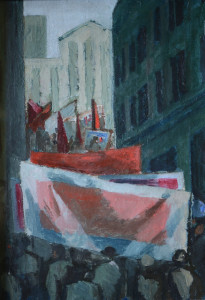For many on the Left, the Spanish Civil War may have been a somewhat romantic affair. But it soon turned into an epic disappointment. It was a disappointment on the scale of WWII.
Pallant House in Chichester is currently showing the first exhibition devoted to British artists during the Iberian conflict. It makes a good case that 1936-1939 was a dry run for 1939-1945.
Had the Republicans prevailed it would at least have given the two other European Axis powers something to chew on. As things stood, it merely gave them aerial bombing practice.
It is well documented that the losing side, that of the Last Great Cause, found themselves in a three-way struggle for power between communists, anarchists and Trotskyites.
But that for me is what gives this painting by Quentin Bell a moving sense of the ideal. The May Day banners are red, and that for now is all you need to know.
They move in a tidal swell. They move away from the artist and his audience. It is as if their progress is towards something that no one can yet see. It could be a new dawn. It could be a disaster.
You can count less than 20 demonstrators, but the effect is of many more. This atmospheric painting throbs with crowd appeal. It appeals to our sense of strength in numbers.
Yet as in so many grand ventures, not everyone makes it out alive. Quentin’s brother Julian joined up as an ambulance driver and was killed just days after this painting was made.
And so a promising young poet, a son of a painter and a critic (Vanessa and Clive Bell) was killed mending potholes near Madrid. The horror of it gave his mother a breakdown.
So in that sense May Day Procession augur’s badly. Indeed the whole war augured ill. And yet the power of this image – and of the many banners and posters in the show – is undiminished.
There must be something about a crowd like this that Power and/or Money finds less and less able to tolerate. Look back at the future in 1937; there’s not a riot squad in sight.
Conscience and Conflict can be seen at Pallant House, Chichester, until 15 February 2015, then from 7 March to 7 June at the Laing Gallery, Newcastle.

No Comments